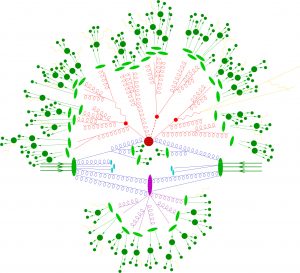
ENP (Exploring New Physics) is a so-called “Iniziativa Specifica” of the INFN Commissione IV (Theoretical Physics), investigating the phenomenology of elementary particles at present and future colliders. In fact, after the discovery of the Higgs boson, occurred in 2012 by the ATLAS and CMS collaborations at CERN, the Standard Model of fundamental interactions (strong and electroweak) stands as a consistent theory, well supported by the experimental observations. However, one is not capable of explaining phenomena like dark matter, baryonic asymmetry or neutrino oscillations.
From the theory viewpoint, the Standard Model exhibits the so-called hierarchy problem: due to quantum corrections, the Higgs boson mass increases at high energies as the square of the energy scale, to the point of diverging for mass values of the order of the Planck mass (the highest allowed value for an elementary particle). Furthermore, the Standard Model does not explain why one has three families of quarks and leptons, with the components of the third family (top and bottom quarks, tau lepton and its neutrino) being much heavier than the first two families.
Therefore, the so-called New Physics models have been built up, extending the Standard Model to high energies and able to explain such experimental observations and solve the conceptual issues. These theories agree with the Standard Model at low energies.
The ENP network aims at exploring the phenomenology of such models, paying special attention to the searches for physics beyond the Standard Model carried out at the LHC and ultimately at future colliders.
At the same time, one undertakes precision studies of the Standard Model itself, and especially of QCD (Quantum Chromodynamics), the theory of strong interactions, since processes mediated by QCD often give rise to the same final states as New Physics models (backgrounds for the searches beyond the Standard Model).
It is therefore of paramount importance having all backgrounds under control, before any possible claim of discovery of New Physics phenomena.
As for the theories beyond the Standard Model, the ENP group at LNF studies the phenomenology of supersymmetry, which predicts for any Standard Model fermion (boson) a supersymmetric bosonic (fermionic) partner, having the same mass (for an exact supersymmetry) and quantum numbers but the spin.
One also explores models which unify the fundamental forces at high energy (Grand Unification Theories) and predict, among others, a neutral vector boson, named Z’, at the LHC energy, with a mass of the order of the TeV.
Models, labelled as 331 according to their group structure, are capable of explaining the existence of three families and the heaviness of the third one. As such theories even predict vectors and scalars with charge 2, absent instead in the Standard Model, the ENP collaboration intends to explore their phenomenology and support the experimental searches.
Regarding the precise Standard Model computations, one takes particular care about the top quark, the heaviest observed particle, which plays a fundamental role in the New Physics searches, since processes with the production of top quarks are a background for several theories beyond the Standard Model. In particular, the top-quark mass value is pretty relevant for any precision test of the Standard Model and even to claim the stability of our Universe. Within ENP, we intend to study in detail the theoretical uncertainty in the top-mass determination and the interpretation of the reconstructed mass, based on the use of Monte Carlo simulations, in terms of well-posed field theory definitions. Moreover, one explores new methods to compute transition probabilities which, in the Standard Model representation of Feynman diagrams, exhibit two loops, with the ultimate goal of applying such techniques to Higgs-boson production processes.
 INFN-LNF Laboratori Nazionali di Frascati
INFN-LNF Laboratori Nazionali di Frascati